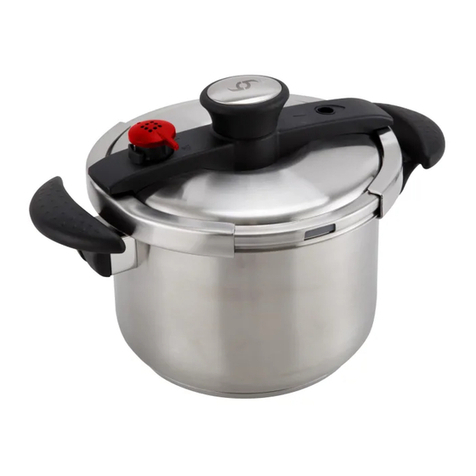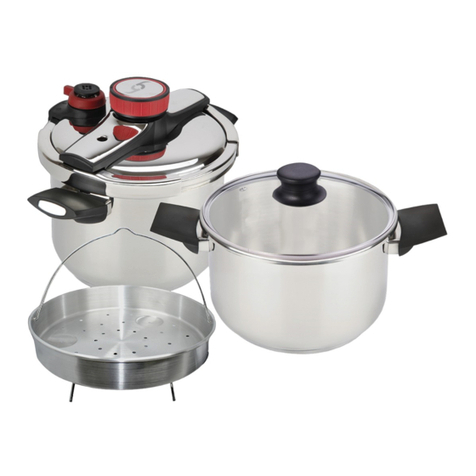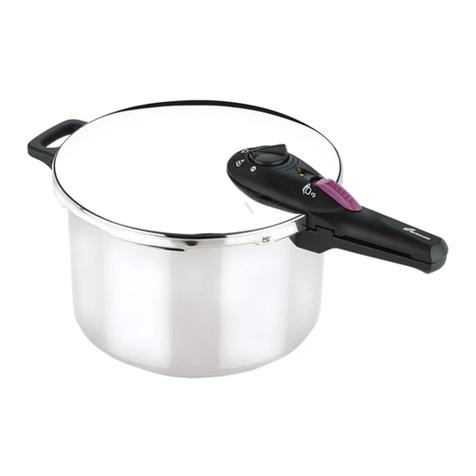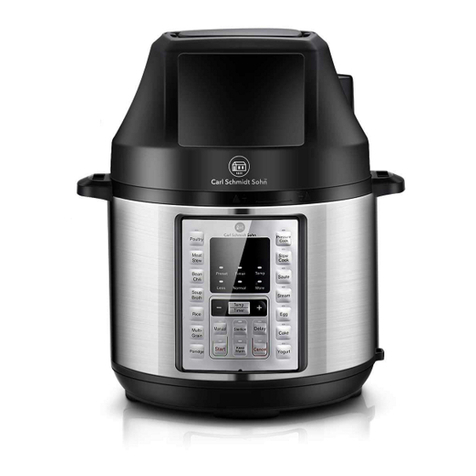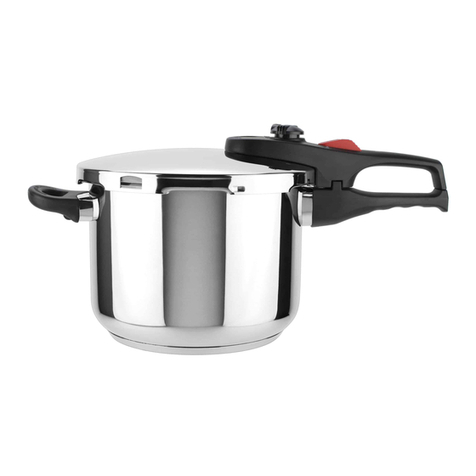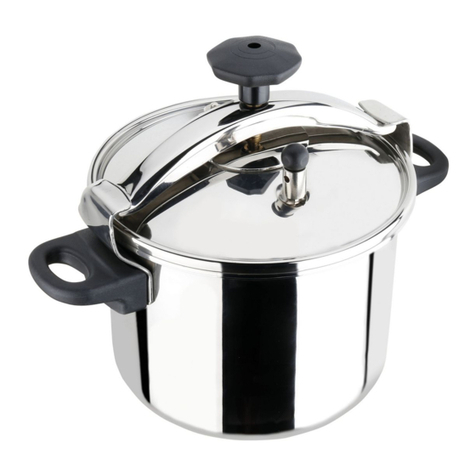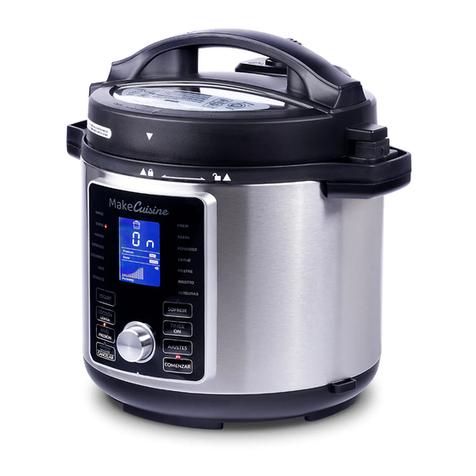Bogner BPCS06041LGL User manual

STAINLESS STEEL PRESSURE COOKER
BPCS06041LGL
USER’S MANUAL
Lifetime Performance
Read carefully and save for future reference

TABLE OF CONTENTS
IParts
II Important safety information
III Safety devices
IV Special features
V How to use
VI Trouble shooting
VII Cleaning and maintenance
VIII Questions and answers
IX Cooking times
I. PARTS

II. Important safety information:
To reduce the risk of personal injury or property damage, basic safety
precautions should always be followed, including the following:
1. Read all instructions.
2. The appliance is not intended for use by persons (including children)
with reduced physical, sensory or mental capabilities, or lack of experience
and knowledge, unless they have been given supervision or instructions
concerning use of the appliance by a person responsible for their safety.
3. Always check the vent pipe before use. Hold cover up to light and look
through vent pipe to be certain it is clear.
4. Always check the air vent/cover lock to be sure it moves freely before use.
5. Do not fill pressure cooker over 2⁄3 full. For soup, grains, and dry beans and
peas which expand during cooking, do not fill cooker over 1⁄2 full. Overfilling
may cause a risk of clogging the vent pipe and developing excess pressure.
See food preparation instructions.
6. Do not pressure cook applesauce, cranberries, rhubarb, cereals, pastas,
split peas, dried soup mixes, or any dry beans and peas as these foods tend
to foam, froth, and sputter and may block the vent pipe, pressure relief valve,
overpressure plug, and air vent/cover lock.
7. This appliance cooks under pressure. Warning! Improper use may result
in scalding injury. Make sure the pressure cooker is properly closed before
operating.
8. Do not place the pressure cooker or attempt to pressure cook in a heated
oven.
9. Extreme caution must be used when moving a pressure cooker
containing hot liquids. Do not touch hot surfaces. Use handles.
10. Do not open pressure cooker until the unit has cooled and all internal
pressure has been released, airvent/cover lock has dropped, and no steam
escapes when the pressure regulator is removed. Do not force it open. Any
pressure in the cooker can be hazardous.
11. To ensure safe operation and satisfactory performance, replace the
overpressure plug everytime you replace the sealing ring or sooner if it
becomes hard, deformed, cracked, worn, or pitted. It is recommended
that the sealing ring and overpressure plug be replaced at least every two
years.
12. When normal operating pressure is reached, the pressure regulator will
begin to move. Gradually lower the heat to maintain a slow, steady rocking
motion. If the pressure regulator is allowed to rock vigorously excess steam
will escape, liquid will be evaporated, food may scorch, and the cooker may
be damaged.
13. Warning! Do not use pressure cooker on an outdoor LP gas burner or gas
range over 12,000 BTU’s.
14. Do not use this pressure cooker for other than intended use.
15. Do not use this pressure cooker for frying with oil.
ASMM Stainless Steel Pressure Cooker
MODEL ASMM22-3L ASMM22-4L ASMM22-6L ASMM22-7.5L
CALIBER
CAPACITY
Φ22cm
3 L 4 L 6L 7.5 L
WORKING
PRESSURE 80kPa
Φ22cm Φ22cm Φ22cm

16. Do not use this pressure cooker for cooking without liquids.
17. Do not use any parts or attachments other than the ones supplied by
or specified by the manufacturer. The use of accessory attachments not
recommended by the manufacturer may result in injury to persons.
SAVE THESE INSTRUCTIONS
THIS PRODUCT IS FOR HOUSEHOLD USE ONLY.
FIRST USE
Your pressure cooker is like a saucepan in which air is steam is sealed inside
creating pressure within the unit. Under pressure, internal temperatures
in the cooker are raised above the normal boiling point of water, causing
foods to cook faster. At 15 pounds of pressure, a temperature of 250°F (or
121°C) is reached inside the pressure cooker. This higher temperature speeds
cooking. The moist steam atmosphere also tenderizes meats naturally.
It is important to become familiar with the various parts of the pressure
cooker and to read the complete manual before using the unit for the first
time.
Before the first use, remove the sealing ring by simply pulling it out of the
inside rim of the cover. Wash sealing ring, cover and body in hot, sudsy
water. Rinse all parts with warm water and dry. Then replace the sealing
ring, being careful to fit it correctly.
• The pressure cooker should be used on a steady surface. Don’t put the
pressure cooker on an electric stove that has a bigger plate’s diameter than
the cooker’s bottom. When cooking on a gas stove, the fire must not reach
the cooker’s body (Fig. 2).
(Fig. 2)
• Be careful not to point the safety valve window to an area where people
may walk by.
• If steam sprays out from safety valve or the sealing ring is squeezed out
from the safety valve window, the fire must be turned off immediately. The
problem must be found and solved before using again.
• Be very careful when moving the cooker with pressure. Carry it
horizontally and lay down gently. Do not bump it.
• Don’t open the cooker when there is pressure inside. Don’t cook when the
lid is not closed well.
• Don’t store salt, soy sauce, alkali, sugar, vinegar, or steam water inside the
cooker for a long time. Clean and dry it every time after using.
• Don’t use for dry heating. Do not use for frying or baking food.
• Recommended volume of food inside the pressure cooker:
Less than 2/3 of the cooker for non-expansive food such as meat, vegetables,
etc. (Fig. 3); Less than 1/4 of the cooker for expansive food such as rice, beans,
etc. (Fig. 4)

IV. Special features
· The sandwich-bottom of the cooker is made to be strong and reliable.
· The diameter of the sandwich-bottom is bigger than common products,
which makes the cooker absorb heat faster.
· Equipped with special pressure-limiting features to avoid blocking.
Different positions of the pressure-limiting valve has different
functions
Release setting
Low pressure setting (80kPa)
Don’t pull out the pressure-limiting valve when there is pressure
inside.
V. How to use
1. Before use
Check visually and in plain daylight that the steam release valve is not
blocked, see Fig. 8. If it is, run it under water or use a dredging needle.
• It is prohibited to put anything on top of the pressure-limiting valve.
(Fig. 5).
III. Safety devices.
We have designed and equipped multi-devices for safety.(Fig.6)
· The open-preventing device ensures the lid to be closed properly as well
as safely.
· The three-degree pressure-releasing device ensures it is safely used.
(Fig.6)
1.Pressure-limiting valve: According to requirement select the high pressure
setting or the low pressure setting.
2. Safely open-preventing value: it will raise when the pressure up to 4kPa.
3. Sealing ring/Safety window: When the pressure-limiting valve and the
safety valve are invalid, the sealing ring will be squeezed out from the safety
window to ensure using safely.
4. Opening button: To open the lid, you must push the button.

(Fig. 8.)
2. Closing the lid.
Align the mark “O” on the lid with the mark “O” on the lower handle to close
it properly. Turn clockwise align the handles and push the button forth and
lock the handles tightly. (Fig.9)
3. Heating
In order to raise the temperature quickly, heat the cooker on strong fire
until the safely open-preventing valve begins to work. Pay attention not to
use stronger fire than needed. It is normal that a little steam seeps from
the safely open-preventing valve after heating for a while. There should be
no steam seeps after the open-preventing valve rises and the cooker works
normally. When the pressure-limiting valve is raised and steam comes out
continuously and gives off a “squeak”, fire should be turned down. It is at
this time same that you should start taking in account the heating time.
(As per part X)
CAUTION:
Heating time is taken in account from the time the pressure-limiting
valve starts to work to the time that you turn off the fire.
◆ Stand by and watch while cooking.
◆ Don’t touch the cooker’s metal surface with your hands or other body
part. Cook carefully and use the handles to avoid a burn.
4. Turning off fire, releasing pressure and opening the lid.
Two ways to open the pressure cooker after cooking is done:
1. Natural cold. When heating time is up, turn off the fire and leave it for a
while waiting for the pressure to be reduced. Take off the lid when the safely
open-preventing valve goes down. The opening procedure is contrary to the
closing. Push the opening button back when you open the lid. Contrarotate
upper handle to align the mark “O” on the lid to and the mark “O” on the
lower handle to open the lid. (Fig.10)

◆ Don’t push the button until the safety valve comes down.
◆ When cook pasty food such as porridge, shake the cooker slightly
before opening.
2. Cooling down quickly. Sometimes it needs cooling down quickly, put the
cooker on a level place and shower the cooker with cold water slowly until
the safety valve comes down (Fig. 11, opening lid is the same as above).
(Fig. 11)
Caution: Avoid water flowing into the cooker through safely
open-preventing valve and the pressure limiting.
Note: Push the button to open lid, then the button naturally slides to a
ready-to-close setting. If the button goes back, you should push it forward.
Otherwise the lid won’t be normally closed. (Fig.9)
VI. Trouble shooting.
If any problem emerges, you shall turn off the fire immediately and take the
cooker to a level place and rinse the cooker with water slowly to reduce the
temperature and the pressure. Find the reason and solve the problem with
the table below.
Problem
Steam comes out from the
underside of the lid
Lid can’t close properly
1. Sealing ring is dirty.
2. Sealing ring is too old.
The shape of the lid has changed
with time. Change the lid.
Steam and liquid leaks
from the safety valve
suddenly
When cooking, the sealing
ring is suddenly forced out
from the safety valve window
and steam is let out.
The safety function of the locking
pin is working. The release hole
of pressure limiting valve is
blocked.
Take the cooker away from the fire
and dredge the release hole. After it
is cool, take down the pressurelimi-
ting valve and clean the hole of pre-
ssure limiting valve.
The safety valve has lost its
function.
The safety function of the sealing
ring is working. Maybe another
device has lost its function.
The sealing ring is aged and
has lost its function.
Change safely open preventing
valve.
Take the cooker away from the
fire. After it is cool, clean and check
all the safety devices. Change the
ones which have lost its functions.
Change the sealing ring.
1. Clean the sealing ring, cooker’s rim
and lid.
2. Change the sealing ring.
Potential cause Solutions

• VII. Cleaning and Maintenance.
To ensure the correct operation of your pressure cooker, follow these
cleaning and maintenance recommendations after each use:
· Wash the pressure cooker after each use using water with a little mild
liquid soap.
*For your first time use – after cleaning, fill with water and heat it up for half
an hour to get rid of any residual smell.
· Never use bleach or products containing chlorine, as these will alter the
quality of the steel. Don’t scrape the cooker’s surface with hard materials
such as metal to avoid abrasion. Don’t touch the cooker with other kinds
of metal to avoid electro chemical corrosion.
· Don’t store food inside the cooker for a long time.
· Do not overheat your pan when empty.
Maintenance of the sealing ring (fig. 12):
· After each use, clean the seal and the rim where it fits.
• Wash the seal using a sponge and mild liquid soap. Dry it completely.
Never wash the seal in the dishwasher.
• Put the seal back in place.
Maintenance of the safely open-preventing valve, the
pressure-limiting valve and the steam-releasing pipe
· Check visually and in plain daylight that the steam release valve is not
blocked. If it is, run it underwater. Also check the correct operation of the
safety valve. Check that the sealing ring is correctly positioned. If this seal
is missing or damaged, leaks may appear when you use your pressure
cooker.
· Check the steam-releasing pipe and the safely open-preventing valve. If
it is blocked you may use a dredging needle and then wash and rinse the
pipe with water(fig.13). Special dismantling as follows:
· Safety open-preventing valve: Switch clockwise, then dismantle it (fig 14).
Then wash it Fig.15
Caution: Don’t lose small parts such as pressure-limiting valve. There
is no problem if the color of the sealing ring has changed. It is advised
to change the sealing ring once every two years depending on the
frequency of use; but it must be changed immediately if there is any
damage or if it changed its shape. Please contact the manufacturer for
replacement parts. Do not use substitutes.
·Storage: keep it in a dry and cool place. You may store the lid upside
down on the pressure cooker.

VIII. Questions and Answers
Q: What can be done if the food prepared in the pressure cooker has
more liquid than desired?
A: with the cover removed, simmer to evaporate the excess liquid.
Q: How does one calculate cooking times?
A: Remember to begin timing as soon as the pressure regulator begins to
rock gently. It is very important to accurately time the cooking period. If you
find that the food is not completely done after the time is up, simply bring
the cooker back up to pressure and cook the food a minute or two longer.
Q: When cooking first begins, is it normal for steam to escape and
moisture to form on the cover and between the handles?
A: It is normal for steam to escape and a slight amount of moisture leakage
to form on the cover and between the handles when cooking first begins. If
leakage continues, the cover handle may not be properly aligned with the
body handle and, therefore, the air vent/cover lock cannot engage.
Q: Why does rice turn a grey color?
A: Cooking under high temperature and high pressure, the amino acids
and saccharides are decomposed by the heat. Thus the food containing
rich proteins and carbohydrates may change its color to grey. But this is
harmless and the taste will not change.
Q: After heating certain foods, liquid sprays out from the safety valve.
A: When heating liquid foods mixed with sugar; they will spray out from the
safety valve because of the high pressure steam inside the cooker. When
cooking this kind of food, don’t cook with pressure on, which means not to
place the pressure-limiting valve on.
Q: What do I do if I accidentally heated my pressure cooker when empty
and dry.
A: Turn off the fire immediately and let it cool naturally. Don’t pour water
onto the cooker.
COOKING TIPS
· Brown meats, poultry, and even some vegetables — like chopped onions,
peppers, or carrots — first and then deglaze the pot for more intense flavor.
· Don’t overdo the liquid.Because food cooks in a closed, sealed pot when
cooking under pressure, you have less evaporation and should therefore use
less cooking liquid than when cooking in a conventional pot. Regardless
of what you’re cooking, however, always use enough liquid. A good rule of
thumb is at least 1 cup of liquid. Never fill the pot more than halfway with
liquid.
· Don’t fill any pressure cooker with too much food.Never fill a pressure
cooker more than two-thirds full with food.
· Remember that even pieces mean evenly cooked food.Food should be cut
into uniform-sized pieces so that they cook in the same amount of time

Food
Beef 1/2 15-20 Very mushy Cut into
pieces
Chop 1/2 8-12 Meat and
bone are
separated
Cut into
pieces
Pork
shank /
Pork
knuckle
1/2 15-20 Meat and
bone are
separated
Cross-
cutting
Chicken 1/2 8-10 Meat and
bone are
separated
Whole
chicken
Fish 1/3 2-4 Well cooked
Lamb 1/3 8-12 Well cooked
Zong Zi 10-15 Well cooked
Corn 2/3
2/3
5-8 Well cooked
Sweet
potato 2/3 6-10 Well cooked
Rice 1/4 4-6 Well cooked,
good smell
Porridge 1/3 10-15 Mushy
Legume 1/4 12-16 Well cooked
Tremella 2/5 15-25 Very mushy
Volume
of food+
water
Results
Time after steam
starts spraying out
steadily from the
pressure-limiting
valve
Remarks
Notes: The times mentioned above are just for reference. Users can adjust
the time according to their practical experiences.
IX. Cooking times
This manual suits for next models
4
Table of contents
Other Bogner Electric Pressure Cooker manuals

